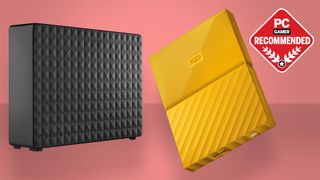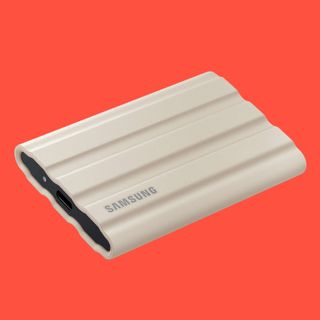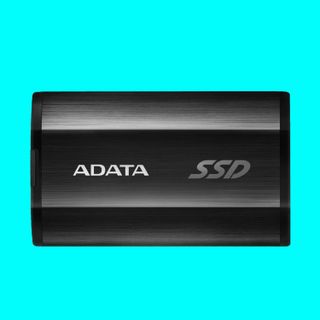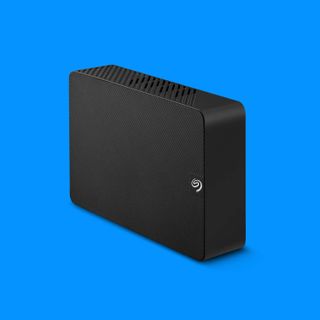Best external hard drives in 2024
Grab one of the best external hard drives to increase your storage space or backup your PC.

🎧 The list in brief
1. Best overall
2. Best budget
3. Best portable
4. Best large capacity
5. Best rugged
6. Where to buy
7. FAQ
It wasn't all that long ago when external hard drives used to be enormous cubes, that made black box recorders on commercial airliners look petite in comparison. Today, the vast majority of them are lightweight and compact, and offer masses of storage for very little money.
The Samsung T7 Shield is the best overall external HDD drive we've tested so far, even though it's not technically an HDD. It's fast, lightweight, and very reasonably priced. But if you want to save even more, then the Adata SE800 is the best budget external drive, though it's quite hard to find in stores. When it comes to carrying around huge amounts of data, though, then you'll find that the Seagate Expansion drive is the best large capacity external HDD.
Whether you're looking to add to your gaming desktop PC's storage or find more space for your gaming laptop, you'll find the best external HDDs below. Grab one of these, and you'll never have to worry about storage for a long, long time.

Nick's been mildly obsessed with storage for as long as he's been using PCs and is always looking to add an extra drive or two to his machines. He's also lost count of the number of HDDs and SSDs he's tested over the years, but he knows exactly what's hot and what's not.
The Quick List

The best overall
The Samsung T7 Shield ticks all of the right boxes for an external drive. Fast, robust, compact, and with up to 4TB on offer. Sure, it's not actually a HDD, but you really can't go wrong with this one.

The best budget
The Adata SE800 is the ideal choice for anyone looking to buy a little bit of additional external storage but not spend a fortune. It's very small and portable, but you're not going to get the best performance out there.

The best portable
The WD My Passport is the ideal choice for anyone looking for lots of storage that they can carry around with them. The 1TB version is really lightweight but the heavier 4TB model offers a better storage-to-price ratio.

The best large capacity
With the largest version offering 20TB of HDD space, you'll never be left wanting with the Seagate Expansion Desktop Drive. You'll need to sacrifice portability, of course, and it's not one for outright speed.

The best rugged
If you're worried about protecting your data on your travels, then the LaCie Rugged external HDD will ease your fears. It's as tough as it looks and very reasonably priced.
Recent updates
Updated April 18, 2024 to simplify the buying guide format, to make it quicker and easier to find the product you want. We'll be updating the recommendations as we test new external HDDs.
Best overall external HDD



Specifications
Reasons to buy
Reasons to avoid
✅ If you need lots of fast, portable storage: The T7 Shield has the right balance of price, performance, and capacity.
❌ If you want cheap external storage: SSD prices have risen quite a bit of late and the T7 Shield isn't quite the bargain it used to be.
The Samsung T7 Shield is the best overall external hard drive, even though it's technically an NVMe SSD. Designed for the "creative professionals and consumers on the go," you can use it outside or stuff it in a bag without worrying about breaking it or compromising your data.
It’s rated IP65 durability classifying it as dustproof and water resistant. Water resistant isn’t the same as waterproof, so if it gets dropped into a toilet, you’re running a 50/50 shot of it working, depending on how long it was submerged.
The T7 Shield is compatible with game consoles, too, which is great if you're looking for a nondescript way to expand your storage. Some of us at PC Gamer use it to keep games for benchmarking laptops and PCs, and loading games like Horizon Zero Dawn from the T7 Shield didn't present any issues, such as dips in performance after playing for a while.
The drive comes with a USB Type-C to Type-C cable and a Type-C to Type-A cable, which works on PCs, Macs, consoles, and Android devices. The T7 is available in beige, black, and blue and is offered in either 1TB, 2TB or 4TB capacities. The pricing for the 2TB is the best of the range, as the 1TB feels too expensive for the amount of storage and the 4TB is far too pricey.
It's a great tiny little drive you never have to worry about breaking daily. While it may be overkill for some in this rugged form factor if you are one of those content creators working in extreme conditions or just a drop-prone klutz like yours truly, it's a safe bet.
Read our full Samsung T7 Shield 1TB review.
Best budget external HDD



2. ADATA SE800
Our expert review:
Specifications
Reasons to buy
Reasons to avoid
✅ If you want a great external HDD at a great price: Adata's products are all good value for money, and the SE800 doesn't cut any corners to achieve this.
❌ If you want this specific drive: The SE800 is a last-gen model and is quite hard to find in stores. Newer models are more expensive, unfortunately.
Adata's SE800 is our recommendation for the best budget external HDD. Like the Samsung T7 Shield, it has an NVMe SSD inside, but it uses TLC NAND memory for improved performance and drive lifespan.
The SSD is connected to a USB interface, specifically a 10 Gbps USB 3.2 Gen 2 one. Although newer drives use the speedier, 20 Gbps USB 3.2 Gen 2x2 interface, the SE800 is still good for 1,000 MB/s data transfers in both directions. That’s around twice as fast as any SATA-based drives, including internal SSDs connected natively via SATA.
What is especially unusual is SE800’s IP68 rating, a characteristic hinted at by the pop-off cover over the USB Type-C port. It means the drive is rated impervious to dust ingress and can survive immersion in up to 1.5 meters of water for 30 minutes. That makes it unique among these SSDs, and, what’s more, given the competitive pricing, you’re getting that IP rating effectively for free.
In testing, we found the SE800 to easily deliver its claimed 1,000 MB/s for sequential read/writes, while notching up 4K random throughput comparable to the competition at 21 MB/s for reads and 40 MB/s for writes. The only downside is that the sustained performance drops to around 260 MB/s after around 15GB of internal drive traffic.
That’s a little off the pace of some alternatives, but it’s not enough to spoil an otherwise highly appealing package.
Best portable external HDD



3. WD My Passport 4TB
Our expert review:
Specifications
Reasons to buy
Reasons to avoid
✅ If you need simple portable storage: There's no better way of carrying around 4TB of data, that you can just plug into any PC and have it immediately work.
❌ If you need rapid data transfers: It's a standard HDD inside the swish case so it won't be anywhere near as fast as an external SSD.
We really like WD’s My Passport and think it's the best portable external HDD right now. It’s not as compact or fast as the Samsung T5 and it can’t withstand an armageddon like the LaCie XtremKey, but at up to 4TB for $110, it offers copious storage space at a good value. We also like that Western Digital fares well each time cloud backup provider Backblaze releases a hard drive reliability report.
The 4TB model is compact and weighs just 210 g. You probably wouldn’t want to try and jam one into a shirt pocket, but they’re almost as portable as a smartphone, just a little chunkier. The 1TB Passport is slightly thinner and weighs a mere 120 g if you don't need as much space.
No external power supply is required in order to use WD's drive—plug in the USB cable and start backing up your files. You can also install WD's backup software to automate the process. Just don't expect SSD-level data transfers but even so, with a peak of 640 MB/s, it's as fast as any internal HDD.
WD also goes the extra mile with password protection and hardware encryption. And if you're looking to make a fashion statement, you can select a My Passport in various color options.
Best large capacity external HDD



4. Seagate Expansion Desktop Drive 8TB
Our expert review:
Specifications
Reasons to buy
Reasons to avoid
✅ If you need lots of terabytes on the go: SSDs bigger than 2TB get very expensive so if you need to travel with a lot more than that, this is your best option.
❌ If you just want to plug it in and use it: The need for a separate, external power supply makes the Seagate a bit fiddly to use if you do a lot of travelling.
If you need to go big when you leave home, Seagate's 8TB Expansion drive is the best large-capacity external HDD. It's not exactly the fastest external hard drive, though, as you'll barely get anything more than 150 MB/s during both read and write data transfers.
What you are getting is masses of storage, that you can easily take with you, for proportionally very little money. For example, the 18TB model is regularly on sale at around $300, which is a ridiculous level of capacity for the money. It becomes a little less cost-effective, though, as you come down the storage ranks—this 8TB version is around the $150 mark.
It's USB 3.0 compatible, so you have a drive that'll plug into most PCs and laptops, though it does require an external power supply (which is provided with the drive). That knocks its portability down a notch or two, as you'll need to carry two items around with you.
Slow transfer speeds and external power requirement aside, there's little to touch the Seagate Expansion drive for sheer portable data capacity.
Best gaming laptops | Best gaming keyboards | Best gaming mouse
Best gaming motherboards | Best graphics cards | Best gaming monitors
Best rugged external HDD


5. LaCie Rugged 2TB
Our expert review:
Specifications
Reasons to buy
Reasons to avoid
✅ If you need a seriously tough drive: LaCie has given this HDD a level of protection that few circumstances will defeat.
❌ If you need a speedy drive: Even for an HDD, this external drive isn't very fast and compared to an SSD, it's a veritable snail.
For ultimate portable drive toughness, the LaCie Rugged is by far the best rugged external HDD. When you think about what external hard drives are used for, durability suddenly becomes essential. It might look like a doggy chew toy but LaCie's portable HDD is as tough as they come and even has a rubber cover around the edges to dampen the shock from any impacts.
While we absolutely recommend that you don't test this out at home, you can drop this thing from a fair height, and it'll stay perfectly intact.
The latest version of LaCie's Rugged only supports a USB Type-C connection but the speeds it operates at are pretty slow. We found that it consistently hit around 130 MB/s in read-and-write tests, which isn't very fast, even for an HDD.
You can pick up the LaCie relatively cheaply, despite all the durability, with the 2TB model typically being sold around the $110 mark. You can go bigger but we recommend the 2TB because it will last so long that it'll store your files for years, and it's nicely priced.
If you're careless with how they pack their bag, or you genuinely take your PC files on more extreme outings, this is the external HDD for you.
Where to buy
Where are the best external HDD deals?
In the US:
- Amazon - Discounts galore on top brand external drives
- Walmart - 1TB external HDDs from as little as $50
- B&H Photo - Save up to $200 on portable storage
- Best Buy - Deals on Seagate, LaCie, and WD external drives
- Target - Masses of big brand USB external HDDs
- Newegg - Big savings to be found on portable drives
In the UK:
Best external HDD FAQ
What type of external hard drive is best?
Your two main options for external drives are a traditional spinning platter hard drive (HDD) and a solid-state drive (SSD). Your SSD is more akin to a standard USB stick where you're storing all the data in little flash memory chips rather than writing it onto a metal platter. That makes them more robust but also more expensive and lower capacity.
Hard drives are still valuable because they can provide cheap, huge data storage volumes, And if you don't need to access that data quickly or regularly, they're fine. Transfer speeds of hard drives are a fraction of what you'll get from a quality SSD.
An SSD, however, is far quicker and generally smaller, which makes them more portable. Their speed means they're far better suited to be an extension of your game library because you can play directly from the SSD itself.
Which lasts longer: SSD or HDD?
Generally, SSDs are the more durable of the two. They don't have any moving parts and are more resistant to temperature and shock... such as being tossed in a bag and dropped. But carefully looked after, a hard drive can last for years without a problem.
What are the disadvantages of SSDs?
The main disadvantage is their price/capacity metric. They are more expensive to make. Therefore, you will get less storage capacity for your money with an SSD than with a hard drive.
The other disadvantage is that recovering lost data from a solid-state drive is much harder, often impossible. Though if you've shattered your HDD to pieces, the same could be said for it, too!
The biggest gaming news, reviews and hardware deals
Keep up to date with the most important stories and the best deals, as picked by the PC Gamer team.

Nick, gaming, and computers all first met in 1981, with the love affair starting on a Sinclair ZX81 in kit form and a book on ZX Basic. He ended up becoming a physics and IT teacher, but by the late 1990s decided it was time to cut his teeth writing for a long defunct UK tech site. He went on to do the same at Madonion, helping to write the help files for 3DMark and PCMark. After a short stint working at Beyond3D.com, Nick joined Futuremark (MadOnion rebranded) full-time, as editor-in-chief for its gaming and hardware section, YouGamers. After the site shutdown, he became an engineering and computing lecturer for many years, but missed the writing bug. Cue four years at TechSpot.com and over 100 long articles on anything and everything. He freely admits to being far too obsessed with GPUs and open world grindy RPGs, but who isn't these days?

Randy Pitchford is 'a hit maker,' says Take-Two CEO: 'We've already identified many potential growth opportunities for the Borderlands series'

The way Embracer's talking about The Lord of the Rings should say one thing to fans: 'Fly, you fools!'

Assassin's Creed Shadows does not need an internet connection to run: 'You will be able to play the entire journey offline'
Most Popular



